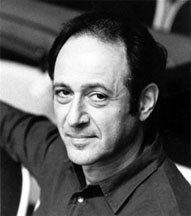Then the narration moved to a musical "chicken or the egg" question—which came first: melody or rhythm? I decided it had to be rhythm, since one of the first sounds that a human hears, pre-natally, is the pulse of the mother’s aorta. Of course I had a recording of that sound so the ocean became a pulse, and it sounded a bit like a timpani. Then that rhythm slowly faded into the constant drum pulse heard at the beginning of Steve Reich’s work, Drumming, and after a few minutes when the rhythmic figure had become more complex, it faded into the sound of African drumming.
 Steve Reich
Steve Reich
Then we were off and running for twenty hours. The final program considered the future of music, with answers by various musicians and music critics. Perhaps the most unusual answer was the one given by composer Henry Brant, who stated that he thought humanity would reach a state of music pollution where performance would be outlawed because there would be “too much of a good thing.” The program finally ended with Peter Allen singing "Everything Old is New Again," the same live version that Ann Reinking dances to in the film All That Jazz.
Having said that, looking back on the early minimalism of the late 1970s I think it can be concluded that at that point the circle began again. After all, we had been through the Renaissance, Baroque, Classical, Romantic and Contemporary periods of music. In the latter period we had gone through serialism, dodecaphony (12-tone), aleatoric, and ended up with the complete spiritual improvisation by Stockhausen in some of his writings.
So let’s go back to the minimalism of Philip Glass.
 Philip Glass (photo by Annie Leibowitz)
Philip Glass (photo by Annie Leibowitz)
Steve Reich really seemed to anticipate Glass with his work Come Out—a work based on a tape loop of a young man saying the sentence fragment "come out to show them." By the end of the piece there are 8 simultaneous loops of the same voice and the sound has converted from English to a bizarre-sounding machine. The sound of the piece is like the sound of a phonograph needle stuck in the groove. That’s essentially the impression made on early listeners to Philip Glass’s music. However, astute people noticed how the music kept changing in subtle ways.
For example, here is a section of Knee Play 3 from the opera Einstein on the Beach The first time through just listen and consider its structure.
It’s not just the same thing over and over again. Listen again and just listen for when the voices sing “One.”
Beginning to understand? The structure of the section is like this 24 times 1,2,3,4; 12 times 1,2,3,4,1,2,3; 24 times 1,2,3; 12 times 1,2,3,1,2.
Much of Glass’s music in the early days is structured in this way.
I remember the night I first saw the Philip Glass Ensemble perform at the Roxy on Sunset. It was an inspiring evening and I attended the concert with William Malloch who for many years was the music director of KPFK in Los Angeles. The whole time I knew him for 20 years, he wore his hair in a long gray pony tail and sported a long gray beard. He knew a great deal about music. (I’ll explain some of his achievments in the blog later.) He was always making witty remarks and commenting about the ensemble's tendency to play rather high-speed music and stop on a dime, he said, "You know what I like about this group- -none of those pompous Baroque ritards!" At that time the PG Ensemble featured Jon Gibson on sax as well as Dickie Landry. The singer was this attractive woman named Iris Hiskey, and it always seemed as though she never needed to take a breath. You can hear her perform some unbelievable stuff on the old Tomato release of Einstein on the Beach.
If you’re interested in hearing some of the music of Philip Glass, go to Room 51 on the second floor of the Classroom. Take me there now.
If you need to leave, Go to initial page of site.
If you are interested in advertising a music-related business in the pages of the classroom, please send us an e-mail regarding rates by clicking here.